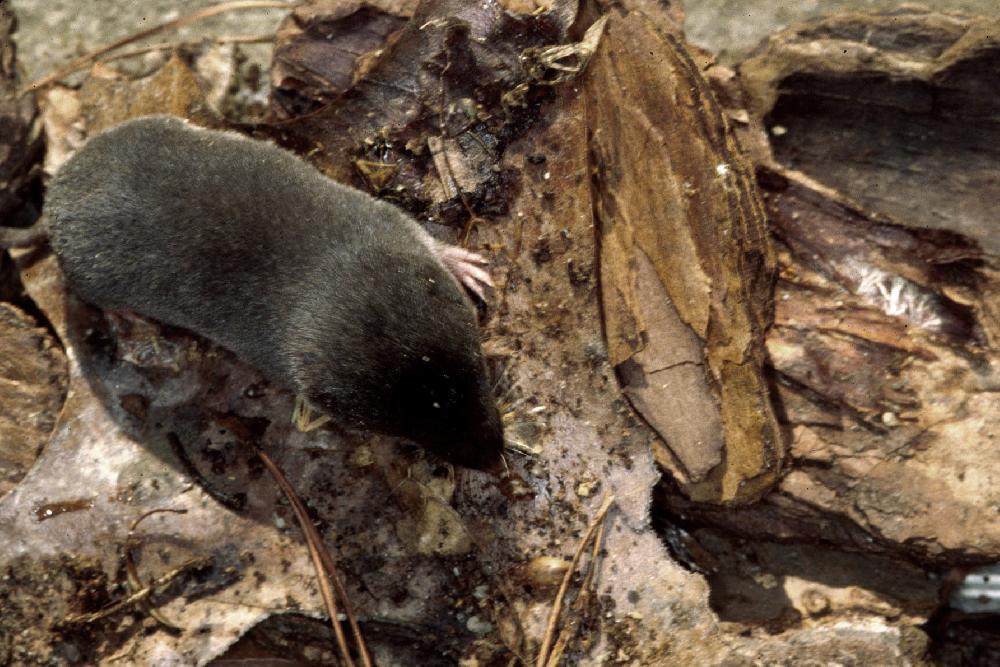The short-tailed shrew is the only poisonous mammal in North America. The poison is both a neurotoxin and a hemotoxin. The poison is produced by the submaxillary salivary gland, and is present in the saliva. It acts as a slow poison, and immobilizes insects and other prey. Immobilized insects remain alive for three to five days, and provide a source of fresh non-decomposing food. These shrews have a particularly strong musky odor. For this reason, some predators, such as foxes and bobcats, may kill these shrews but not eat them. It is one of the most widely distributed mammals in the park.
Species Measurements:
- Adult Total Length: 95-108 mm (3?-4? in.)
- Tail: 18-31 mm (?-1? in.)
- Hind Foot: 12-20 mm (1?-3? in.)
- Weight: 14-28 g (?-1 oz.)
Physical Characteristics:
The short, dense, velvet fur is uniformly slate gray with slightly paler underparts. The short tail is well haired. In overall length, the short-tailed shrew is the second largest of the eight species of shrews found in the park. However, by weight, it is the heaviest. Shrews possess long tapering snouts and tiny eyes and ears. Hearing and smelling are acute. The tips of the incisor teeth are dark chestnut in color. Shrews have five toes on each foot.
Habitat:
Moist woodlands bordering swamps and streams with some leaf litter, and low herbaceous vegetation seem to be preferred.
Reproduction:
Short-tailed shrews breed from late winter to September. In the park, nursing females have been reported in June, July, and September (Linzey, 1995b). A lactating female was recorded in the spruce-fir zone on September 22 (Smith and Mouzon, 1985). Males in breeding condition have been found in March and September. Gestation lasts 21 to 22 days, and litters usually consist of four to seven young. A female containing four embryos was recorded in the park on July 1 (Linzey, 1995b). Spring young tend to mature more rapidly than autumn young, and may breed in late summer or autumn (George, 1999). Shrew nests are about six to eight inches in diameter, with a two to four inch inside diameter. Nests are composed of finely shredded grasses and leaves. Young are weaned and independent at 4 weeks of age.
Longevity:
Although individuals may live up to 30 months, generally only 11% live more than a year (George, 1999).
Terrestrial Ecology:
Short-tailed shrews make shallow runways beneath the surface litter. They also use the burrows and runways of other animals. Nests of dry leaves and grasses are constructed beneath logs, stumps, and rocks. Individuals generally are solitary, except during the mating season.
Although short-tailed shrews are active both day and night during all seasons of the year, they are most active at night, and in the early morning (George, 1999). They tend to be more active on cloudy days rather than on sunny or rainy days.
Feeding Habits:
They feed primarily on earthworms, millipedes, insects, arachnids, and molluscs. In the park, short-tailed shrews have been reported feeding on millipedes, insects, insect larvae, gastropods, earthworms, and the fungus Endogone (Komarek and Komarek, 1938; Linzey and Linzey, 1973).
The short-tailed shrew is the only poisonous mammal in North America. The poison is both a neurotoxin and a hemotoxin. The poison is produced by the submaxillary salivary gland, and is present in the saliva. It acts as a slow poison, and immobilizes insects and other prey. Immobilized insects remain alive for three to five days, and provide a source of fresh non-decomposing food.
Home ranges average about 2.5 hectares (George, 1999). Individual ranges overlap; short-tailed shrews are not thought to be territorial.
Predators and Defense:
These shrews have a particularly strong musky odor. For this reason, some predators, such as foxes and bobcats, may kill these shrews but not eat them. In the park, known predators include black rat snakes (Elaphe obsoleta), barred owls (Strix varia), and spotted skunks (Spilogale putorius).
Parasites:
The flea Epitedia wenmanni testor has been reported in the park (Linzey, 1995b).
The short-tailed shrew inhabits the forests and grasslands of the eastern half of the United States and adjacent Canada, south to Georgia and Alabama. The range extends west to Saskatchewan, North Dakota, and Central Nebraska.
The short-tailed shrew can be found in almost all kinds of habitats at all elevations. It is one of the most widely distributed mammals in the park.
References:
George, S.B. 1999. Northern Short-tailed Shrew. Pages 47-49. In: Wilson, D.E. and S. Ruff (editors). The Smithsonian Book of North American Mammals. Smithsonian Institution Press, Washington, D.C.
Komarek, E. V. and R. Komarek. 1938. Mammals of the Great Smoky Mountains. Bulletin of the Chicago Academy of Science 5(6): 137-162.
Linzey, D. W. 1995a. Mammals of Great Smoky Mountains National Park. The McDonald & Woodward Publishing Company, Inc., Blacksburg, Virginia.
Linzey, D. W. 1995b. Mammals of Great Smoky Mountains National Park-1995 Update. Journal of the Elisha Mitchell Scientific Society 111(1): 1-81.
Linzey, D. W. and A.V. Linzey. 1973. Notes on Food of Small Mammals from Great Smoky Mountains National Park, Tennessee-North Carolina. Journal of the Elisha Mitchell Scientific Society 89 (1 and 2): 6-14.
Smith, T.R. and J.M. Mouzon. 1985. Small Mammal Survey in the Spruce-Fir Zone of Great Smoky Mountains National Park. Typewritten final research report. In library of Great Smoky Mountains National Park, Gatlinburg, Tennessee.

